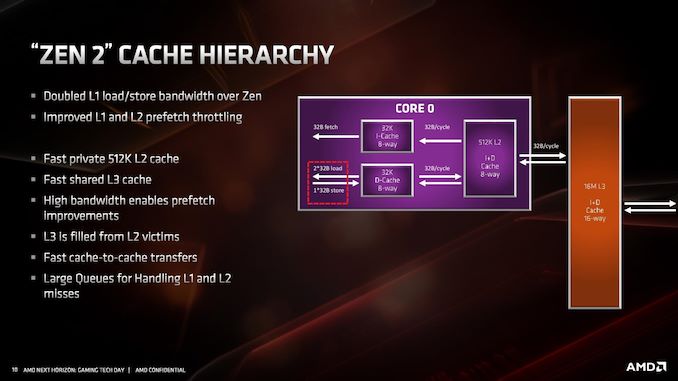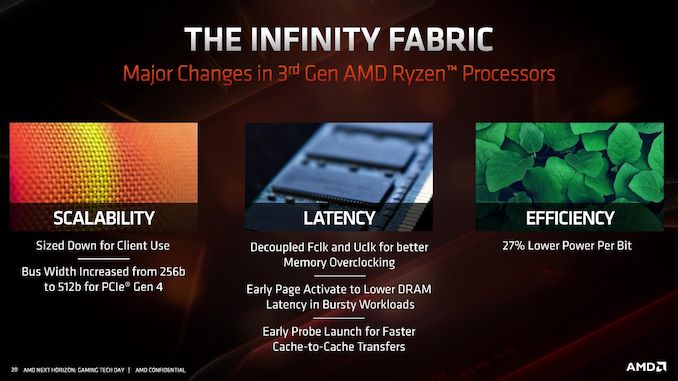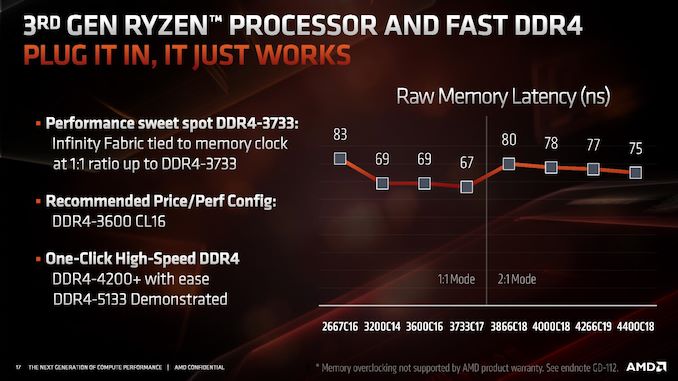AMD Zen 2 Microarchitecture Analysis: Ryzen 3000 and EPYC Rome
by Dr. Ian Cutress on June 10, 2019 7:22 PM EST- Posted in
- CPUs
- AMD
- Ryzen
- EPYC
- Infinity Fabric
- PCIe 4.0
- Zen 2
- Rome
- Ryzen 3000
- Ryzen 3rd Gen
Cache and Infinity Fabric
If it hasn’t been hammered in already, the big change in the cache is the L1 instruction cache which has been reduced from 64 KB to 32 KB, but the associativity has increased from 4-way to 8-way. This change enabled AMD to increase the size of the micro-op cache from 2K entry to 4K entry, and AMD felt that this gave a better performance balance with how modern workloads are evolving.
The L1-D cache is still 32KB 8-way, while the L2 cache is still 512KB 8-way. The L3 cache, which is a non-inclusive cache (compared to the L2 inclusive cache), has now doubled in size to 16 MB per core complex, up from 8 MB. AMD manages its L3 by sharing a 16MB block per CCX, rather than enabling access to any L3 from any core.
Because of the increase in size of the L3, latency has increased slightly. L1 is still 4-cycle, L2 is still 12-cycle, but L3 has increased from ~35 cycle to ~40 cycle (this is a characteristic of larger caches, they end up being slightly slower latency; it’s an interesting trade off to measure). AMD has stated that it has increased the size of the queues handling L1 and L2 misses, although hasn’t elaborated as to how big they now are.
Infinity Fabric
With the move to Zen 2, we also move to the second generation of Infinity Fabric. One of the major updates with IF2 is the support of PCIe 4.0, and thus the increase of the bus width from 256-bit to 512-bit.
Overall efficiency of IF2 has improved 27% according to AMD, leading to a lower power per bit. As we move to more IF links in EPYC, this will become very important as data is transferred from chiplet to IO die.
One of the features of IF2 is that the clock has been decoupled from the main DRAM clock. In Zen and Zen+, the IF frequency was coupled to the DRAM frequency, which led to some interesting scenarios where the memory could go a lot faster but the limitations in the IF meant that they were both limited by the lock-step nature of the clock. For Zen 2, AMD has introduced ratios to the IF2, enabling a 1:1 normal ratio or a 2:1 ratio that reduces the IF2 clock in half.
This ratio should automatically come into play around DDR4-3600 or DDR4-3800, but it does mean that IF2 clock does reduce in half, which has a knock on effect with respect to bandwidth. It should be noted that even if the DRAM frequency is high, having a slower IF frequency will likely limit the raw performance gain from that faster memory. AMD recommends keeping the ratio at a 1:1 around DDR4-3600, and instead optimizing sub-timings at that speed.













216 Comments
View All Comments
GreenReaper - Wednesday, June 12, 2019 - link
The last you heard? It says clearly on page 6 that there is "single-op" AVX 256, and on page 9 explicitly that the width has been increased to 256 bits:https://www.anandtech.com/show/14525/amd-zen-2-mic...
https://www.anandtech.com/show/14525/amd-zen-2-mic...
To be honest, I don't mind how it's implemented as long as the real-world performance is there at a reasonable price and power budget. It'll be interesting to see the difference in benchmarks.
arashi - Wednesday, June 12, 2019 - link
Don't expect too much cognitive abilities regarding AMD from HStewart, his pay from big blue depends on his misinformation disguised as misunderstanding.Qasar - Thursday, June 13, 2019 - link
HA ! so that explains it..... the more misinformation and misunderstanding he spreads.. the more he gets paid.......HStewart - Thursday, June 13, 2019 - link
I don't get paid for any of this - I just not extremely heavily AMD bias like a lot of people here. It just really interesting to me when Intel release information about new Ice Lake processor with 2 load / s store processor that with in a a couple days here bla bla about Zen+++. Just because 7nm does not mean they change much.Maybe AMD did change it 256 width - and not dual 128, they should be AVX 2 has been that way for a long time and Ice Lake is now 512. Maybe by time of Zen 4 or Zen+++++ it will be AVX 512 support.
Korguz - Thursday, June 13, 2019 - link
no.. but it is known.. you are heavily intel bias..whats zen +++++++++ ????
x 86-512 ??????
but you are usually the one spreading misinformation about amd...
" and support for single-operation AVX-256 (or AVX2). AMD has stated that there is no frequency penalty for AVX2 " " AMD has increased the execution unit width from 128-bit to 256-bit, allowing for single-cycle AVX2 calculations, rather than cracking the calculation into two instructions and two cycles. This is enhanced by giving 256-bit loads and stores, so the FMA units can be continuously fed. "
HStewart - Thursday, June 13, 2019 - link
Zen+++++ was my joke as every AMD fan jokes about Intel 10+++ Just get over itx-86 512 - is likely not going to happen, it just to make sure people are not confusing vector processing bits with cpu bits 64 bit is what most os uses now. for last decade or so
Intel has been using 256 AVX 2 since day one, the earlier version of AMD chips on only had two combine 128 bit - did they fix this with Zen 2 - this is of course different that AVX 512. which standard in in all Ice Lake and higher cpus and older Xeon's.
Qasar - Thursday, June 13, 2019 - link
sorry HStewart... but even sone intel fans are making fun of the 14++++++ and it would be funny.. if you were making fun of the process node.. not the architeCture..."
x-86 512 - is likely not going to happen, it just to make sure people are not confusing vector processing bits with cpu bits 64 bit is what most os uses now. for last decade or so " that makes NO sense...
HStewart - Thursday, June 13, 2019 - link
One more thing I stay away from AMD unless there are one that bias against Intel like spreading misinformation that AVX 512 is misleading. and it really not 512 surely they do not have proof of that.AVX 512 is not the same as x86-512, I seriously doubt we will ever need that that but then at time people didn't think we need x86-64 - I remember original day of 8088,. no body thought we needed more 64meg AVX-512 is for vectors which is totally different.
just4U - Thursday, June 13, 2019 - link
I always have a higher end Intel setup and normally a AMD setup as well.. plus I build a fair amount of setups on both. No bias here except maybe.. wanting AMD to be competitive. The news that dropped over the past month was the biggest for AMD in over a decade HS.. If you can't even acknowledge that (even grudgingly..) then geez.. I dunno.This has been awesome news for the industry and will put intel on their toes to do better. Be happy about it.
Xyler94 - Monday, June 17, 2019 - link
HStewart, please. You don't stay away from AMD at all. You take ANY opportunity to try and make Intel look better than AMD.There was an article, it was Windows on ARM. You somehow managed to make a post about Intel winning over AMD. Don't spew that BS. People don't hate Intel as much as you make them out to be, they don't like you glorifying Intel.